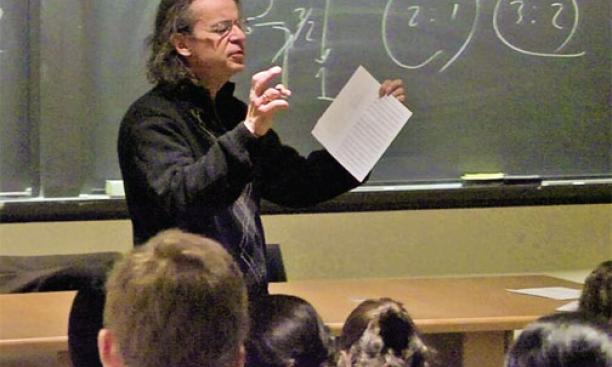

The year 2013 marks the 60th anniversary of the Council of the Humanities, which from its perch in the Joseph Henry House, makes its creative presence felt across our campus. At a time when the utility of liberal arts curricula is being questioned, I am happy to report that the humanities are alive and well at Princeton. In recent years, new certificate programs ranging from translation and intercultural communication to Latino studies have emerged, and last spring, a robust 19 percent of our seniors earned degrees in humanistic disciplines, well above the national average. If history, which straddles the humanities and social sciences, is included, this figure rises to a quarter of the graduating class. The vitality of the humanities at Princeton owes much to strong departments and programs, exceptional faculty, and students with catholic interests, but it is multiplied by the work of the council — a crossroads for humanists of every stripe and, more recently, colleagues from other divisions of our University.
Founded in 1953 by Professor of Classics Whitney J. Oates ’25 *31 and led today by Stuart Professor of Philosophy Gideon Rosen *92 and veteran executive director Carol Rigolot, the council currently coordinates 23 interdisciplinary programs and committees that stretch from the Ancient World to contemporary American culture; from political philosophy to linguistics. Since its beginnings, the council has been an incubator, nurturing projects in their formative years. The Department of Comparative Literature, the Program of Freshman Seminars in the Residential Colleges, the Program in Gender and Sexuality Studies, and the programs now encompassed by the Lewis Center for the Arts were hatched in the council’s academic nest and nurtured there while developing their own strong wings. Put another way, the council is a master of reinvention, deriving its shape, though not its fundamental mission, from the ever changing needs and interests of our campus.
The council also hosts a rich array of visiting fellows from around the world for periods ranging from a few days to three years, to say nothing of our own juniors and seniors, two dozen of whom come together once a month to explore ideas under the aegis of the Behrman Undergraduate Society of Fellows. Over the past 60 years, countless scholars, writers, and artists have been guests of the council, spanning the spectrum from up-and-coming postdoctoral fellows to celebrated figures in the world of arts and letters, among them Eudora Welty, Arthur Miller, and Meryl Streep. Another set of guests are the Ferris, McGraw, and Robbins visiting journalists, who come from The New York Times, The Washington Post, NPR, the BBC, and many other organizations to spend a semester teaching their craft in undergraduate seminars. Their unofficial dean is John McPhee ’53 of The New Yorker, who has taught in the program since 1974.
Last but certainly not least, the council sponsors a number of interdisciplinary courses on both European and Asian cultures. One of these is the legendary team-taught, doublecredit “Interdisciplinary Approaches to Western Culture: History, Religion, Philosophy, Literature and the Arts,” where 45 incoming students are immersed in what they call “intellectual boot camp” with six faculty members each term. The course’s popularity is understandable. As one freshman recently put it, “it sets you up for so many different disciplines because it builds you a scaffolding of all of Western thought.”
Two of the council’s newest initiatives expand this concept further. One is the Interdisciplinary Doctoral Program in the Humanities, affectionately known as I-HUM, where selected graduate students receive an extra fellowship year in order to explore a new field that will broaden their research agendas. Participants receive a joint degree in the program and their home department. At the undergraduate level, I-HUM’s counterpart is the new interdisciplinary certificate in humanistic studies, where students can chart their own paths through the curriculum by creating bridges from their area of concentration to another field, thereby illuminating one with the questions and approaches of the other. Students are encouraged to forge thoughtful connections between the humanities and arts; between the humanities and related social sciences; between different cultures; or between the humanities and sciences. They may also serve as pioneers in the burgeoning field of digital humanities, which uses technology to address perennial questions and formulate new ones, whether that means mining digitized texts for linguistic patterns or reconstructing historic sites through geospatial imaging.
Let me close with a brand-new council venture. Through this imaginative program, pairs of scientists and humanists collaborate on projects that can benefit from their dual expertise. In one such partnership, musicologist Anna Zayaruznaya and computer scientist Rebecca Fiebrink *11 are seeking to help users around the world engage with a medieval manuscript in collaborative ways. Engineer Naomi Leonard ’85 and composer Dan Trueman *99 are studying feedback and interaction in musical composition, while philosopher Mark Johnston *84 and astrophysicist Ed Turner are exploring philosophical issues in inflationary cosmology and the multiverse. These projects, which would have been unthinkable 60 years ago, illustrate the council’s unique ability to help our faculty and students interweave strands of learning that, together, reveal new and exciting sections of the tapestry of life, making for an anniversary that all of us can celebrate!
(For the record: The original version of this story published in the Nov. 14, 2012, issue of PAW incorrectly reported the class year of John McPhee.)

